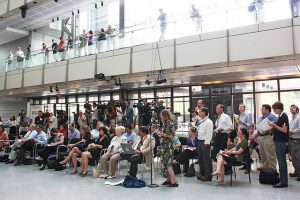102 9.12 Methods: News Conference
News conferences range in style and size from televised presidential news conferences, with hundreds of reporters assembled, to informal sessions, with one source and a handful of questioners.

The news conference undoubtedly is the journalist’s least-favorite method of news gathering. From the viewpoint of the source, the news conference is a time-saving convention. But from the reporter’s perspective, there is little to recommend it. If the news conference is televised, reporters for newspapers find that their questions and the answers to them have been broadcast on television or placed as a video file on a news Web site before they can write their own stories.
Follow-up and clarification questions are difficult at large news conferences. Reporters who have prepared particularly well often do not reap the benefits of their preparation. They may not have a chance to ask their questions, and, if they do, they reveal their lines of inquiry to competitors.
Despite the limitations of news conferences, they continue to be a standard method that busy or celebrated people use for giving information to the media. Behind the scenes at press conferences, the work of public relations staff members is critical. For many news conferences, public relations staff have prepared handouts that give the essential information about the announcements to be made that day.
In these packets, reporters find the basics related to the announcement – names, titles, dates, places and decisions – that free them to ask more substantial and interpretative questions than they otherwise would be able to ask. From the viewpoint of the public relations staff, these information packets are designed to promote accuracy in the news reports that follow the conference.
Questions in news conferences should be short. Reporters who seem to be making speeches instead of asking questions draw the anger of their colleagues. So do the unprepared, whose questions do not advance the topic but require the source to repeat information that well-informed reporters have already acquired. Well-prepared and attentive listeners are in the best position to present important follow-up questions during news conferences.

